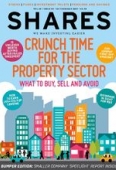Archived article
Please note that tax, investment, pension and ISA rules can change and the information and any views contained in this article may now be inaccurate.
Strong cash flow is the secret to a great company

Uncertainty hangs over the future of post-Brexit Europe, where key elections offer potential for further shocks in 2017. Nevertheless, the continent is home to some world class companies generating growth and strong cash flows in the face of current political and economic turbulence.
One fund that seeks out such star turns through a proven and distinct investment process is Liontrust European Growth (GB00B4ZM1M76), which recently celebrated its 10-year anniversary.
The £77.8m unit trust invests in a concentrated and equally weighted portfolio of companies from developed continental Europe using Liontrust’s ‘Cashflow Solution’ process.
What do the fund managers look for?
Managers James Inglis-Jones and Samantha Gleave believe the most important determinant of shareholder returns is company cash flow.
They hunt for companies that generate significant free cash flow from their asset base. They also want firms which are lowly valued on their cash flow and run by management who ‘allocate their cash flow in an intelligent way’.
Cash flow relative to operating assets and cash flow relative to enterprise value are two measures which tell Inglis-Jones how much a company generates on its investments and how investors are valuing its cash flow.
‘Good’ businesses will have high returns on cash invested and a low requirement for substantial investment. They will also have high cash flow relative to their market value, priced cheaply as expectations for their profit growth are low among investors.
Creating a best buy
Inglis-Jones’ process enables him to identify the best 20% of stocks in his universe to create a ‘top quintile’ list of possible buys.
‘What is great about the Cashflow Solution process is you get a huge variety of businesses and sectors in the top quintile and that gives you a more consistent return,’ enthuses Inglis-Jones.
‘The big difference between us and the peer group is the equally weighted approach to constructing the portfolio.’
He seeks to understand how cash flow has been generated and to be sure there is a cash flow culture in the business.
‘It is a childishly simple process really,’ says the modest Inglis-Jones, whilst stressing that on a 10-year view ‘we’ve delivered more than double the return of the market’.
What's the outlook for European stocks?
The fund manager says he holds an upbeat assessment of the outlook for European equities this year. He is cognisant of the need to limit exposure to some extreme valuations being afforded to stocks meeting certain investment characteristics.
His investment process steers clear of companies with very high forecast earnings growth. ‘In our view, mispricing of stocks often stems from overconfidence in forecasts of future profitability made by company managers and sell-side brokers, which often turn out to be unreliable,’ he comments.
‘We don’t speak to any brokers at all and I rarely read their research. It is all geared towards a forecast view of the future, whereas we are focused on what cash we can see in the business here today,’ adds Inglis-Jones.
He avoids companies whose cash flow scores are deteriorating or which are too highly valued, as well as high growth companies that are not generating enough cash to support their growth plans.
When it comes to portfolio disposals, stocks are sold if they fall out of the top quintile in his scoring system.
Is this a foolproof system?
There are certain market conditions when the process will temporarily struggle. However, Inglis-Jones never wavers in applying the Cashflow Solution Process.
‘If a process works all the time everyone would soon adopt it and it would lose its potency. A good investment process is sustained by the fact that from time to time it does not perform that well,’ he says. ‘This causes some people to abandon the approach which serves to sustain the anomaly.
‘Investors need to know it’s also a commonplace feature of successful funds – a fact highlighted recently by a US study by Joel Greenblatt that showed that for top quartile funds over 10 years, 80% of them had spent at least three of that 10 year period in the bottom quartile.’
What's in the portfolio?
High-quality names in the portfolio include Swedish beauty product retailer Oriflame, which operates akin to ‘the Avon ladies of Eastern Europe’. The fund manager says it is a cash flow growth stock. ‘Oriflame has forecast turnover growth of 8% over the next couple of years. On book value, it looks very expensive, but it generates huge amounts of cash from the asset base.’
Another cash flow star turn is Nexans, a French cable manufacturer that is valued at not much more than its book value.
Recent value picks in the energy and financial sectors include Swedish oil and gas explorer and producer Tethys Oil and Italian bank Mediobanca, the latter ‘in the top quintile on the cash flow screen, looking very cheap on cash flow measures and yet shunned as the sector is so disliked’.
Inglis-Jones has also topped up the fund’s position in Deutsche Pfandbriefbank following recent price weakness and added another banking stock in Svenska Handelsbanken.
Important information:
These articles are provided by Shares magazine which is published by AJ Bell Media, a part of AJ Bell. Shares is not written by AJ Bell.
Shares is provided for your general information and use and is not a personal recommendation to invest. It is not intended to be relied upon by you in making or not making any investment decisions. The investments referred to in these articles will not be suitable for all investors. If in doubt please seek appropriate independent financial advice.
Investors acting on the information in these articles do so at their own risk and AJ Bell Media and its staff do not accept liability for losses suffered by investors as a result of their investment decisions.
Issue contents
Big News
Editor's View
Great Ideas Update
Larger Companies
Main Feature
Money Matters
Smaller Companies
Story In Numbers
- UK Banking Shares Performance
- General Retailers Shares Performance
- Story In Numbers - Fishing Republic
- 37%
- Five profit warnings in 15 months
- 1st time in 12 months: Investors give bullish signal with fund inflows
- From $17m to zero: Kenmare Resources’ earnings up in smoke
- $205.2bn: The value of failed takeover deals so far in 2017

 magazine
magazine











